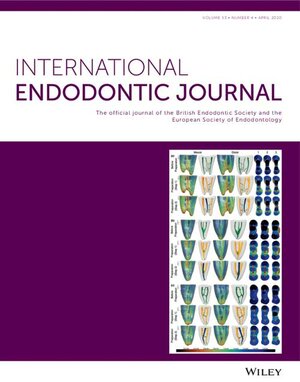Exosomal circ_0003057 promotes osteo/odontogenic differentiation of hDPSCs by binding with EIF4A3 through upregulated parental gene ANKH
Abstract
Aim
Elucidating the mechanism of osteo/odontogenic differentiation of human dental pulp stem cells (hDPSCs) is crucial for advancing regenerative endodontic procedures (REPs). Circular RNAs (circRNAs) play significant regulatory roles in stem cell differentiation, and exosomes are crucial for intercellular communication. This study investigated the role of exosomal circRNAs in hDPSCs during osteo/odontogenic differentiation using in vitro and in vivo evidence.
Materials and Methods
We isolated hDPSCs from dental pulp tissues of healthy immature permanent teeth. CircRNA microarray analysis was used to identify differentially expressed circRNAs. Exosomes were extracted from hDPSCs using ultracentrifugation, and circRNA content was detected. Functional validation of exosomal circRNAs was performed using siRNA/overexpression plasmids and subcutaneous transplantation in to nude mice. The biological effects of circ_0003057, EIF4A3 and ANKH were determined using real-time quantitative polymerase chain reaction (qRT-PCR), western blotting (WB), alkaline phosphatase (ALP) staining and activity, alizarin red staining (ARS), quantification and immunofluorescence staining. EIF4A3 was identified as a potential binding protein (RBP) for circ_0003057 in the database, and this binding relationship was confirmed using RNA pull-down and RIP assays. qRT-PCR and WB were performed to determine whether the host gene ANKH of circ_0003057 was activated.
Results
circ_0003057 expression was increased during osteo/odontogenic differentiation of hDPSCs, whereas circ_0003057 downregulation suppressed this process. EIF4A3 was confirmed to be a binding protein of circ_0003057 and was upregulated during osteo/odontogenic differentiation of hDPSCs. Further investigation revealed that circ_0003057 upregulation during osteo/odontogenic differentiation led to the upregulation of its parental gene, ANKH. Co-transfection experiments confirmed that circ_0003057 upregulated ANKH, promoting osteo/odontogenic differentiation of hDPSCs.
Conclusions
This study demonstrates that exosomal circ_0003057 promotes osteo/odontogenic differentiation of hDPSCs by interacting with EIF4A3 and upregulating ANKH, providing new insights into the molecular mechanisms underlying this process and its potential applications in regenerative endodontics.

 求助内容:
求助内容: 应助结果提醒方式:
应助结果提醒方式:


